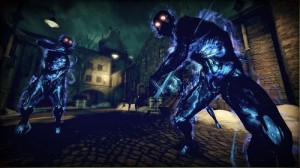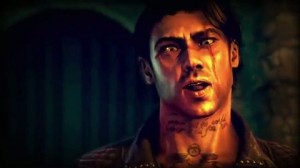 Sometimes you wonder whether the games that you love are the same as those that inspire developers. Does Shigeru Miyamoto look to Ico for inspiration for the forthcoming Zelda game? (he does). Does Square Enix look at western popular western RPG’s when they develop the new Final Fantasy’s? (apparently not). Where am I going with this? Well throughout Shadows of the Damned I found myself frequently wondering whether Suda 51 and Grasshopper had played the classic Acclaim title Shadow Man.
Sometimes you wonder whether the games that you love are the same as those that inspire developers. Does Shigeru Miyamoto look to Ico for inspiration for the forthcoming Zelda game? (he does). Does Square Enix look at western popular western RPG’s when they develop the new Final Fantasy’s? (apparently not). Where am I going with this? Well throughout Shadows of the Damned I found myself frequently wondering whether Suda 51 and Grasshopper had played the classic Acclaim title Shadow Man.
Shadow Man was one of my favourite games of all time. I played it on the N64 and it was a great alternative to all the cartoon platformers that were available at the time. Riding the wave of comic book characters that crossed into videogames (along with the likes of Turok), Shadowman was an adventure game involving platforming and shooting that used an innovative two-handed weapon system. It involved the titular Shadow Man (real name Michael LeRoi) descending through a hellish underworld to find his deceased brother. Facing the spiritis of deceased serial killers and collecting “Dark souls”, Michael used his Shadowgun to take their energy and eventually defeat their evil overlord, the monster named Legion. Michael was aided by a cheery skeleton-creature named Jaunty who spoke in an exaggerated Irish accent.
 Flash forward eleven years and Suda 51 follows bizarre but brilliant niche titles like No More Heroes and Killer 7 with his newest release, Shadows of the Damned. Its not purely his own project though, its a collaboration with Shinji Mikami of Resident Evil fame and the trademark style of both auteurs shows in the final product. For the most part Shadows of the Damned manages to combine the punky aesthetic of Suda’s best work with the accessibility of bigger mainstream releases that Mikami has made successful. Strangest of all, it does so by combining aspects of both designers previous work, and the result is something that coincidently ends up looking, playing and feeling like Shadow Man.
Flash forward eleven years and Suda 51 follows bizarre but brilliant niche titles like No More Heroes and Killer 7 with his newest release, Shadows of the Damned. Its not purely his own project though, its a collaboration with Shinji Mikami of Resident Evil fame and the trademark style of both auteurs shows in the final product. For the most part Shadows of the Damned manages to combine the punky aesthetic of Suda’s best work with the accessibility of bigger mainstream releases that Mikami has made successful. Strangest of all, it does so by combining aspects of both designers previous work, and the result is something that coincidently ends up looking, playing and feeling like Shadow Man.
The combat is third person shooting, but this is no cover based shooter. Enemies don’t tend to fire back, instead advancing like those Las Plagas “zombies” of Resident Evil 4. The player rolls, dives and strafes as they fire an arsenal of occult-inspired weapons. The range of weapons includes a flare-like alternate fire which strips enemies of their protective layer of darkness and allows them to be damaged by other weapons. The process of switching weapons based on enemy types (be they scuttling, crawling “things” or charging armoured “things”) is engaging and the weapons are satisfying to use. In Shadow Man the Shadow Gun was the only weapon the player could use to finish off an enemy, but in Shadows of the Damned the flare weapon is the one you need to use first before you can damage your opponents.
 The phrase “arsenal of weapons” is misleading as the player has one gun which transforms into different variants. The variants themselves are standard (machine gun, pistol, shotgun), but the novelty comes from the fact that the gun you carry is your main companion. Named Johnson, you’re skeletal themed weapon talks and interacts with you throughout the game, guiding you and filling in all the exposition throughout the campaign. He talks in an exaggerated English accent and fulfils exactly the same role as the similarly skeletal sidekick Jaunty did for Michael LeRoi.
The phrase “arsenal of weapons” is misleading as the player has one gun which transforms into different variants. The variants themselves are standard (machine gun, pistol, shotgun), but the novelty comes from the fact that the gun you carry is your main companion. Named Johnson, you’re skeletal themed weapon talks and interacts with you throughout the game, guiding you and filling in all the exposition throughout the campaign. He talks in an exaggerated English accent and fulfils exactly the same role as the similarly skeletal sidekick Jaunty did for Michael LeRoi.
Finally the visual depiction of the descent into the underworld is hugely reminiscent of Shadow Man. The twisted, bleeding corpses, curved paths and walkways, graveyards, misty rivers, bone cages, quivering cadavers and castles made of skulls all look familiar to anyone who played the Acclaim title. For a more recent comparison, titles like Jericho or maybe even Bayonetta are visually similar, but its both more original and varied than Jericho and more viceral and grounded in some kind of reality than Bayonetta.
The structure of the levels isn’t particularly wide or open; there’s one critical path with a few hidden areas to explore. As paths are cleared or keys are obtained the structure and even look of the levels can begin to feel like Ravenholm from Half Life 2. Going up stairs, down mine shafts, up ladders, round corridors, through windows and climbing towers imbues the game with a constant sense of forward momentum and pace with minimal backtracking and constant new visual rewards around each corner.
 This is no platformer or exploration game either. Rather the combat takes centre stage as the main form of progression. Sometimes this devolves into arenas where defeating the requisite enemies opens a door, other times it involves searching for a “key” to open a gate and progress. This is cleverly integrated into the bizarre lore of the game by having you feed gate monsters (grotesque baby faces) with brains or guts or strawberries, which the game latter explains are actually made of ground up tongues. Functionally this means you are finding the right coloured key to open a door, you know, like you did in the first Doom game. Suffice it to say the game feels most engaging when you are moving forward and travelling through the cartoonishly grotesque underworld rather than hanging about fighting waves of enemies or scouring about for a Maguffin to open a door.
This is no platformer or exploration game either. Rather the combat takes centre stage as the main form of progression. Sometimes this devolves into arenas where defeating the requisite enemies opens a door, other times it involves searching for a “key” to open a gate and progress. This is cleverly integrated into the bizarre lore of the game by having you feed gate monsters (grotesque baby faces) with brains or guts or strawberries, which the game latter explains are actually made of ground up tongues. Functionally this means you are finding the right coloured key to open a door, you know, like you did in the first Doom game. Suffice it to say the game feels most engaging when you are moving forward and travelling through the cartoonishly grotesque underworld rather than hanging about fighting waves of enemies or scouring about for a Maguffin to open a door.
The story of the game is close in tone to No More Heroes, with a similarly confident but comical protaganist. Lead character Garcia Hotspur is clearly inspired by the Princess Brides Iñigo Montoya, but rather than looking for the man who killed his father he is trying to find his kidnapped girlfriend Paula who has been taken by the demon Fleming. Garcia and Johnson’s dialogue is full of non sequiturs and the humour misses far more than it hits, but its bizarre and original enough to keep you invested in the characters. The imagery of the game is occasionally shocking enough to startle you out of the slightly languid pace of the gameplay with some early scenes in particular standing out as the most brilliantly vile and gore soaked spectacles in modern videogame history.
For all the imagery and art design of the game is good, the graphics let the whole package down a little. Always looking a little rough, they feel like a technically decent game from four years ago and don’t quite hold up when compared to everything else on the shelves today. Whole areas seem to have excess mist and smoke effects and often level geometry looks like the low detail models that are displayed while the higher level ones are loaded.
Akira Yamaoka, Composer for Shadow’s of the Damned playing Live
Mikami and Suda 51 may be the two big names on the box, but its Akira Yamaoka’s soundtrack that excels. Most famous for the Silent Hill series, Yamaoka’s music here is stunningly good. More than once I put down my pad and simply listened, worried that if I moved on the current musical piece would change. Spanish guitars sweep in and out between industrial soundscapes and eerie, distant strings. Many of the sound effects are evocative of Silent Hill too; the sound of opening gates is the same as the pause sound in Silent Hill 1 if my memory is correct.
 So can a unique visual aesthetic, original storytelling and possibly the best soundtrack in any modern videogame make up for occasionally pedestrian gameplay? The answer is, for the most part, yes. The experience is no where near as groundbreaking as Killer 7, but then just as many gamers hated that games convoluted narrative and on-rails gameplay as loved it. Its not as polished as Resident Evil 5 either, but it feels like it has far more soul and ambition than such a big budget title. Its a little indie gem, a future cult hit and the kind of mid-range, mid budget title that everyone’s saying doesn’t get made any more.
So can a unique visual aesthetic, original storytelling and possibly the best soundtrack in any modern videogame make up for occasionally pedestrian gameplay? The answer is, for the most part, yes. The experience is no where near as groundbreaking as Killer 7, but then just as many gamers hated that games convoluted narrative and on-rails gameplay as loved it. Its not as polished as Resident Evil 5 either, but it feels like it has far more soul and ambition than such a big budget title. Its a little indie gem, a future cult hit and the kind of mid-range, mid budget title that everyone’s saying doesn’t get made any more.
Eleven years after Michael LeRoi travelled into Deadside to save his brother from the demon Legion, Garcia Hostspur is making a very similar trip to save his beloved Paula. If you weren’t there for Michael, now’s your chance to make up for it by helping Garcia. You won’t regret it.
8 superstar Japanese games designers out of 10
